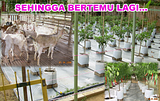( http://en.wikipedia.org/wiki/Forage )
From Wikipedia, the free encyclopedia
Forage is plant material (mainly plant leaves and stems) eaten by grazing livestock.[1] Historically the term forage has meant only plants eaten by the animals directly as pasture, crop residue, or immature cereal crops, but it is also used more loosely to include similar plants cut for fodder and carried to the animals, especially as hay or silage.[2]

Common forages
Grasses
Brachiaria decumbens
Brachiara humidicola
Bothriochloa pertusa
Bothrioochloa bladhii
Heteropogon contortus
Themeda triandra
Panicum maximum
Cenchrus ciliaris
Melinis minutiflora
Setaria sphacelata
Chloris guyana
Cynodon dactylon
Paspalum dilatatum
Hyparrhenia rufa
Echinochloa pyrmaidalis
Leersia hexandra
Hymenachne amplexicaulis
Entolasia imbricata
Intermediate wheatgrass (Thinopyrum intermedium)
Bluegrasses or meadow-grasses (Poa species)
Kentucky bluegrass or smooth meadow-grass (Poa pratensis)
Rough meadow-grass (Poa trivialis)
Texas bluegrass (Poa arachnifera)
Bromegrass or brome (Bromus species)
False oat-grass (Arrhenatherum elatius)
Fescues (Festuca species):
Red fescue (Festuca rubra)
Meadow fescue (Festuca pratensis)
Tall fescue (Festuca arundinacea)
Orchard grass or cock's-foot (Dactylis glomerata)
Reed canary-grass (Phalaris arundinacea)
Ryegrasses (Lolium species):
Annual or Italian ryegrass (Lolium multiflorum)
Perennial ryegrass (Lolium perenne)
Timothy-grass or timothy (Phleum pratense)
Herbaceous Legumes
Stylosanthes sacbea
Stylosanthes humilis
Chamaecrista rotundifolia
Macroptilium atropurpeum
Macroptilium bracteatum
Medicago truncatula
Glycine wightii
Clitoria ternatea
Arachis pintoi
Vigna parkeri
Alfalfa or lucerne (Medicago sativa)
Bird's-foot trefoil (Lotus corniculatus)
Clovers (Trifolium species):
Alsike clover (Trifolium hybridum)
Crimson clover (Trifolium incarnatum)
Red clover (Trifolium pratense)
White clover (Trifolium repens)
Sainfoin (Onobrychis viciifolia)
Sweetclover or melilot (Melilotus species)
Vetches (Vicia species)
Common vetch or tare (Vicia sativa)
Hairy vetch (Vicia villosa)
Bitter vetch (Vicia ervilia)
Vicia articulata Hornem
Vicia narbonensis
Tree Legumes
Leucaena leucocephala
Albizia lebbeck
Acacia aneura
Silage
Corn (maize)
Alfalfa
Grass-legume mix
Sorghums
Oats
Crop residue
Sorghum
Corn (maize) stover
Soybean stover
Foraging
( http://en.wikipedia.org/wiki/Foraging )
From Wikipedia, the free encyclopedia
Foraging theory is a branch of behavioral ecology that studies the foraging behavior of animals in response to the environment in which the animal lives. Foraging theory considers the foraging behavior of animals in reference to the payoff that an animal obtains from different foraging options. Foraging theory predicts that the foraging options that deliver the highest payoff should be favored by foraging animals because it will have the highest fitness payoff.
Robert MacArthur, J M Emlen, and Eric Pianka, first proposed an optimal foraging theory in an independent paper in 1966. This theory argued that because of the key importance of successful foraging to an individual's survival, it should be possible to predict foraging behavior by using decision theory to determine the behavior that would be shown by an "optimal forager" - one with perfect knowledge of what to do to maximize usable food intake. While the behavior of real animals inevitably departs from that of the optimal forager, optimal foraging theory has proved very useful in developing hypotheses for describing real foraging behavior. Departures from optimality often help to identify constraints either in the animal's behavioral or cognitive repertoire, or in the environment, that had not previously been suspected. With those constraints identified, foraging behavior often does approach the optimal pattern even if it is not identical to it.
There are many versions of optimal foraging theory that are relevant to different foraging situation. These include:
The optimal diet model, which describes the behavior of a forager that encounters different types of prey and must choose which to attack
Patch selection theory, which describes the behavior of a forager whose prey is concentrated in small areas with a significant travel time between them
Central place foraging theory, which describes the behavior of a forager that must return to a particular place in order to consume its food, or perhaps to hoard it or feed it to a mate or offspring.
In recent decades, optimal foraging theory has frequently been applied to the foraging behaviour of human hunter-gatherers. Although this is controversial, coming under some of the same kinds of attack as the application of socio biological theory to human behaviour, it does represent a convergence of ideas from human ecology and economic anthropology that has proved fruitful and interesting.
Important contributions to foraging theory have been made by:
Eric Charnov, who developed the marginal value theorem to predict the behaviour of foragers using patches;
Sir John Krebs, with work on the optimal diet model in relation to tits and chickadees;
John Goss-Custard, who first tested the optimal diet model against behaviour in the field, using redshank, and then proceeded to an extensive study of foraging in the Common Pied Oystercatcher.











1 comment:
The responsibility of feeding and caring for pet goats often comes with a hefty price tag, but when it comes to goats, their needs are little different from ours. Get more interesting details about texas goat on this site.
Post a Comment